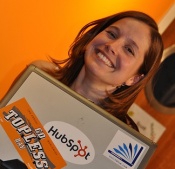Girls in Tech Boston last night was a fantastic event. @just_kate did a great job of the preparation and execution, major kudos go out to her.
I really liked how Kate included a couple of case studies during the panel. They were of two Boston companies, Generation Progress and Shoestring Magazine, who each had some great social media questions. They each explained their business and situation and got to ask the panel some very specific questions.
The advice from @rhappe, @MikeLangford, @CappyPopp was fantastic and if you want a rundown of everything, check out @jmaver and his twitter stream from the event. Below are some of my suggestions.
Shoestring Magazine - Shoestring is an online magazine that has been up since the fall of last year. They offer the "good life for less" and are working on building their revenue model and readership through social media.
- Join the conversation! - The two co-founders of Shoestring have been on Twitter since the early days, have a blog and utilize Facebook. My recommendation to them was to not just use social media to push out their content, but to engage in the conversation. They need to find the influencers in the budget and eco-friendly online communities and join the conversations. Comment on their blogs and interact with them on Twitter and Facebook. Doing so will get the influencers involved in Shoestring and their support will be invaluable.
- Use the team - The full time team at Shoestring consists of just the co-founders, Melissa Massello and Meghan Udell, so having enough time is always an issue. I think they should leverage their freelance writing team to help them engage in the community more. All writers want their work to be read, so give incentives based on links to their articles, number of comments and visitors or other metrics that would encourage them to participate in the community and build a following of their writing.
Generation Progress - GP is a political action committee that raises money through events to support political candidates. They are working to build their community and bring more engaged people to their events.
- Twitter - GP is on Twitter, however I recommend that they expand the focus of their tweets. There is so much good content that would appeal to their target audience. They have the opportunity to tweet about all things political and appeal to the very people they are trying to reach. By building a content stream that is not so focused on what GP is doing, but focused more broadly on what GPs followers are interested in, they will gain more followers and hopefully more engaged attendees.
- Community - GP has a great community that discusses political issues and encourages debate. Unfortunately this is all through a private email group and it's difficult to get new people to sign up. They recognize the need to open this up, but have struggled to move it to a different medium. I think they should come up with a number of different solutions such as a blog with open comments for discussion, a forum or a Twitter handle, and ask the community which they would prefer. It's important with communities that you don't force a decision on them, this would help them find where their users would be willing to move, to help have more people join the conversation.
- Quality vs. Quantity - GP asked a great question about joining more online communities to expand their reach, or focusing on a couple and having higher quality conversations. I think the panel agreed that quality should definitely be their aim. The concern with spreading yourself to thin across a number of communities is that you won't actually engage because you don't have the time. If you don't engage in a community, you won't get the benefit of being on it at all! You should pick one or two to start with, where you know your audience is, and then expand if and when you have time to grow additional communities.


